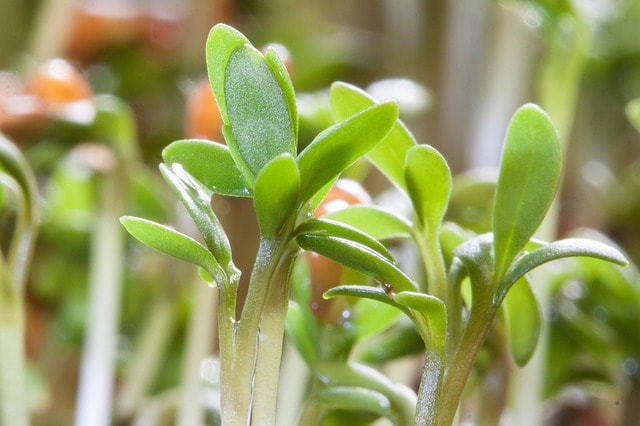
Contents
How to germinate seeds very easily
The easiest and quickest way is to get a germinating jar with a lid with holes and a tab to keep the jar tilted and prevent water from stagnating in the seeds. (As on the picture)
There are dozens of varieties of seeds to be germinated in organic stores or on the online store Biovie (see site and promo code on the site). Avoid at first the mucilaginous seeds.
The seeds must be soaked between 4 and 8 hours on average. The smaller your seeds are, the shorter the soaking time. Often this soaking time is indicated on the packaging.
While soaking and until the sprout is out, leave them in a dark place in your kitchen or place a cloth over them. Once the sprout is out, you can place the jar in a brighter place but never in direct contact with the sun.
Be careful, the seeds will take on volume quickly, so start by placing just 1 or 2 tablespoons of seeds in your jar for soaking.
When the soaking phase is over, empty the water through the holes in the lid and put water back in to rinse them. Repeat the rinsing 2 or 3 times to remove the enzymes that were protecting the seed so that it does not sprout at any time.
Once the last of the soaking water has been removed, place your jar tilted on its base near a window. Every day, rinse your seeds again and drain them. Depending on the variety, you can start eating them between 1 and 8 days. When the sprouts are big enough, keep your jar in the refrigerator to stabilize them. Then every day you can take some to eat with your raw vegetables. You can easily consume one cup worth of sprouts per meal.
You can also make a rotation by having like me, 3 jars to be germinated. This way I can make 3 different varieties and stagger them in time to always have some ready on hand and not get tired.
There are packets of seeds to germinate with several varieties mixed, it is also very good.
Whether you germinate seeds to eat them or to make seedlings for your vegetable garden
But here I am going to speak to you more in details about the light or on the contrary of the darkness which it is necessary to bring to your seeds when you make them germinate.
Some seeds are very demanding in this respect: some need light imperatively while others only start to develop in the dark. Between these two extremes, there are all sorts of variations: light can accelerate germination, slow it down or … have no influence on this stage of a plant’s life.
Small seeds generally prefer light
There is an explanation for this: during germination, the reserves of the small seeds are quickly exhausted, they must quickly manage all alone by making photosynthesis and they do not have neither strength nor time to produce a long jet through several centimeters of ground. Only seeds with little or no burial, which receive light, have a chance to survive. That said, there are exceptions.
In producing sprouted seeds for consumption, I recommend leaving them in a dark place in your kitchen at first, then when the sprouts start to come out move them closer to the window to give them more light.
For the sowing of seeds whose germination requires light, or is favored by the light, it is necessary simply to press them against the wet substrate. You can also spray a little water on them to promote adhesion.
Attention, even if they need light, most of the seeds do not support the direct solar rays.
As for the others, everyone knows that, we generally advise to bury them at a depth equal to 3 times their thickness. In extreme cases, when light inhibits germination, one can put on the seedling an opaque cover of some kind (and watch from time to time because of course, once germinated, all the young shoots need light!)
For barley with a fairly large grain, I let them germinate in a dark corner of my kitchen, then when the sprouts have come out well, I place them on the moistened soil of my pre-prepared trays. I lay a wooden board on top of the seeds and press them down so that the roots stick to the moist soil. I place my trays thus made on shelves in the most obscure places of my kitchen finally I spray with water morning and evening.
When the young shoots reach approximately 5 cm, that is to say at the end of 3 or 4 days according to the temperature, I put them in front of the window so that they green and grow more quickly.
Light requirements for the germination of vegetables and herbs
Those that need light to germinate:
Dill, arrowroot, carrot, celery, lettuce, cape gooseberry, savory.
Those that prefer darkness:
Eggplant, basil, cucumber, all kinds of cabbage, melon, parsley, pepper, pumpkin, tomato.
Seeds indifferent to the presence or absence of light:
Chia, sweet corn, onions and peas.

